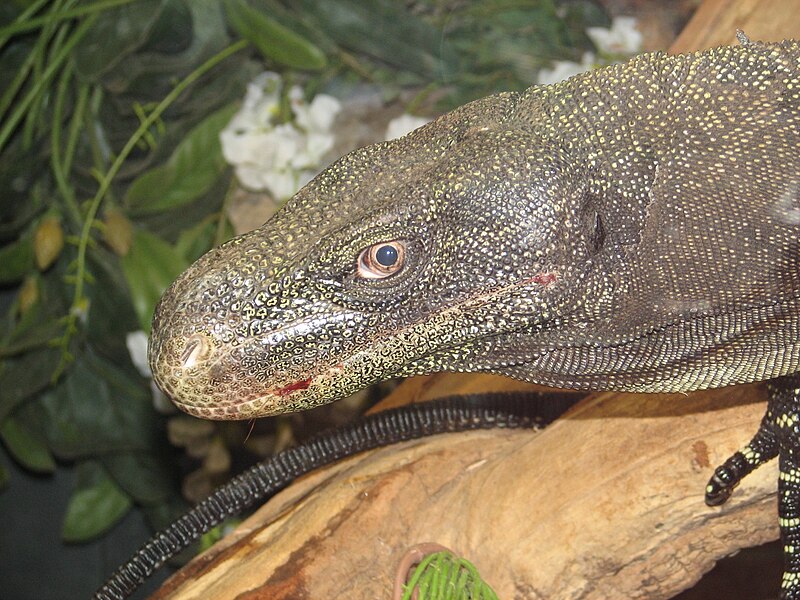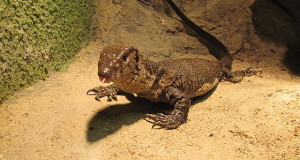Despite – or perhaps because of – its immense size, impressive armament of teeth and scarcity, the spectacular Crocodile Monitor Lizard (Varanus salvadorii) is often considered the crown jewel of private and public monitor collections.
I became acquainted with these formidable giants when they were first imported into the USA, and have cared for several at the Bronx and Staten Island Zoos. Their husbandry is straightforward, but little is known about their lives in the wild. Today I would like to summarize what we do know; please see the article referenced below for notes on captive care.
Description
 Crocodile Monitors approach 9 feet in length – nearly as long as the famed Komodo Dragon, but less stoutly built. There are recurring but unverified reports of much longer individuals.
Crocodile Monitors approach 9 feet in length – nearly as long as the famed Komodo Dragon, but less stoutly built. There are recurring but unverified reports of much longer individuals.
The Crocodile Monitor’s prehensile tail often exceeds 5 feet in length. The body is dark gray to black in color and marked with yellow spots, making for quite a spectacular appearance. The snout area, especially in mature males, is large and bulbous.
Crocodile Monitors are unusually large for canopy dwelling lizards…the 3 foot long black tree monitor is far more typical. However, aided by slender bodies, long claws and prehensile tails, they are very agile climbers.
Their teeth are unique among monitors, being serrated and over-lapping – possibly an adaptation for carrying large prey high above the forest floor.
Range and Habitat
Crocodile Monitors are found only in southern New Guinea. Highly arboreal, they seem restricted to the canopies of mangrove swamps and lowland forests along rivers.
Status
Little studied due to the inaccessibility of their habitat, the Crocodile Monitor’s limited range renders it a conservation concern. Listed on CITES Appendix II.
Reproduction
Females lay 6-12 eggs at a time, and up to 3 clutches per year in captivity (multiple clutches may be a function of food availability), with arboreal nest sites being favored. In common with other tree-dwelling monitors, they likely deposit eggs in tree hollows and similar sites above ground in the wild.
Diet
Their natural diet has been little studied, but probably includes nearly any animal that can be overpowered. Likely candidates would be cuscus, tree kangaroos, naked-tailed rats, bandicoots, possums, bats, birds, frogs, snakes, lizards, invertebrates and carrion.
An Undiscovered Giant in New Guinea?
Long a creature of legend, the Crocodile Monitor is the source of rumors alleging “Papuan Dragons” of 20 feet in length. This specie’s habitat is inaccessible and barely explored….I like to believe that it or an as yet un-described monitor may indeed reach such lengths.
A Calculating Reptile
Like all Varanids, Crocodile Monitors are highly intelligent. One huge adult that escaped its enclosure at the Bronx Zoo wedged himself behind a cage while attempting to hide from myself and a co-worker. As we moved into position to flush him, he very deliberately peered around first one and then the other side of his hideout, trying to keep us both in sight. When we backed off, he followed our progress, again changing position periodically to ascertain where we were.
The lizard remained stationary while we were near, and only ran when we gave him some space. When he did move, the old fellow made unerringly for a more secure retreat that he had obviously “decided upon” while in hiding.
Further Reading
Please see my article Monitor Lizards: an Overview for information about the captive care of this and related species.
A comprehensive field report on the crocodile monitor’s habitat is posted here.
Crocodile Monitor image referenced from wikipedia and originally posted by Ltshears
 That Reptile Blog – Reptile, Amphibian and Exotic Pet Care and Information
That Reptile Blog – Reptile, Amphibian and Exotic Pet Care and Information



i have just got a crocodile monitor for my new vivarium.I would like to know if they are a good pet ,i have a 4ft bosc monitor ,and thuoght i would go for some thing a bit special.My croc monitor is only 1 year old it is a male ,i have not picked him up as yet its still in the reptile shop.Thay have given me a load of tips i just thought you could also give me some please email and let me know Regards jaime jpm fire protection ltd
Hello Jamie, Frank Indiviglio here.
Thanks for your interest in our blog.
They are fascinating animals but a bit large for most private collections – you’ll eventually need a room of at least 10’x10’x10’ to properly accommodate him. Most tend to remain rather high strung and aggressive – in general, not an animal to consider as “handleable”. Although all large monitors can inflict serious bites, crocodile monitors are particularly capable due to the unique serrated teeth and strong jaws.
Please check out mu article Monitor Overview for a bit more info, and please write back and with your observations or questions as time goes on,
Good luck and please keep me posted.
Best regards, Frank Indiviglio.
The longest alleged size I have heard of for the crocodile monitor species is about 5.5 meters which is about 18 feet long so I suspect that in an area that is so little known and the fact that little is known about this animal I suspect that specimens of 18 feet (15 feet being more likely) are possible.
Hello Antonio, Frank Indiviglio here.
Thanks for your interest in our blog. Given how little we know about rainforest canopies, I agree that larger individuals are out there. Unfortunately I have no contacts who can supply reliable proof. Any info you could pass along re the alleged giant you mention would be most appreciated,
Good luck and please keep me posted.
Happy Holidays, Frank Indiviglio.
unfortunatley the only somewhat reliable thing I can point out in the sightings of these animals is that the witnesses commonly report that these animals *fill up* the trees that they lay on which gives some accuracy to the sightings.
Hello Antonio, Frank Indiviglio here.
Thanks for the feedback; let’s hope we get some confirmation as a holiday present…
Good luck and please keep me posted.
Happy Holidays, Frank Indiviglio.
based from what I have seen and based on what I have heard from even reputable biologists the longest crocodile monitors currently grow to a length of 11.5-12 feet long not 9 feet.
Hello Antonio, Frank Indiviglio here.
Thanks for your feedback. If you have seen animals of such size, or know of published records backed by appropriately-documented measurements, I would be most happy to receive more info. The nearly 5-meter-long animal supposedly taken in 1987, that is mentioned in every popular website on the subject seems, as of the last time I looked into this, not to be in the collection of any museum.
When I was writing the graphics for the Croc Monitor exhibit at the Staten Island Zoo a few years ago, I researched the matter in the 3 major US professional herp journals, as well as through my colleagues, and was unable to document the sizes so often credited to these animals. Of course I may have missed something, or one of which I am unaware may have surfaced since then, and I would be most pleased to learn any details you may have.
Thanks, good luck and please keep me posted.
Best regards, Frank Indiviglio.
From what I have read 5 meters (15 feet) appears to be correct A biologist named Dr. Michael Pope had the chance to examine a dead monitor 475cm or 15 feet 5 inches long and numerous other biologists have even accepted a length of 15 feet including Honolulu Zoo authorities and the Wildlife Preservation Society of Australia and to add to the fact that Biologists from other zoos have claimed even having animals of such a length I would certainly place 15 feet as the record since it is coming from biologists themselves who usually don’t accept claims without some form of hard evidence so I won’t exclude 15 feet as a recorded size.
Hello Antonio, Frank Indiviglio here.
Thanks for the update; I’ll keep an eye out for articles and will pass along any new info.
Good luck and please keep me posted.
Best regards, Frank Indiviglio.
Just came to say that the record length is actually 10 feet although i do believe that new guinea harbors monitors 18 feet or even 20 feet but no greater
Hello Antonio, Frank Indiviglio here.
Thanks for your interest. I can’t really add much to what we’ve already discussed; size needs to be authenticated and published in a peer reviewed journal or book in order to be accepted; as you know, the internet is not always reliable in this regard. Please see this entry (page 237) of Varanoid Lizards of the World, which gives a maximum size of 2.65 meters. This is, as far as I know, the best reference that is available via the internet.
Best regards, Frank Indiviglio.
Just wanted to make one more comment about lizard i mentioned before that there are biologists that have claimed a length of 5.5 meters for crocodile monitors. While I don’t believe crocodile monitors get that large the fact that it is biologists reporting this makes me believe that there could be another lizard that is 15 or even 18 feet long and it may reach such a length of it follows the body plan of very slender monitor lizards such as perenties, crocs, and water monitors etc. So that is all I have left to say. Like I said before I do believe there are 15-18 foot lizards but I’m sure a good portion of that length is tail like the crocodile monitor.
Hello Antonio, Frank Indiviglio here.
Thanks for the feedback. Please let me know if you turn up anything new; I’ll keep my eyes open as well.
Best regards, Frank Indiviglio.
I. Looked in the book varanoid lizards of the world and before it said 2.65 meters it also said that it has been reported to exceed or grow over 4.5 meters thats what i also saw on that page are they saying none longer than 4.5 meters have been recorded because im a little confused.
Hello,
When “reported to…” or words to that effect are used, the author is saying that there are rumors, word-of-mouth accounts, perhaps notes in a non-scientific journal but there are no accurately measured specimens or records published in peer-reviewed journals.
Best, Frank